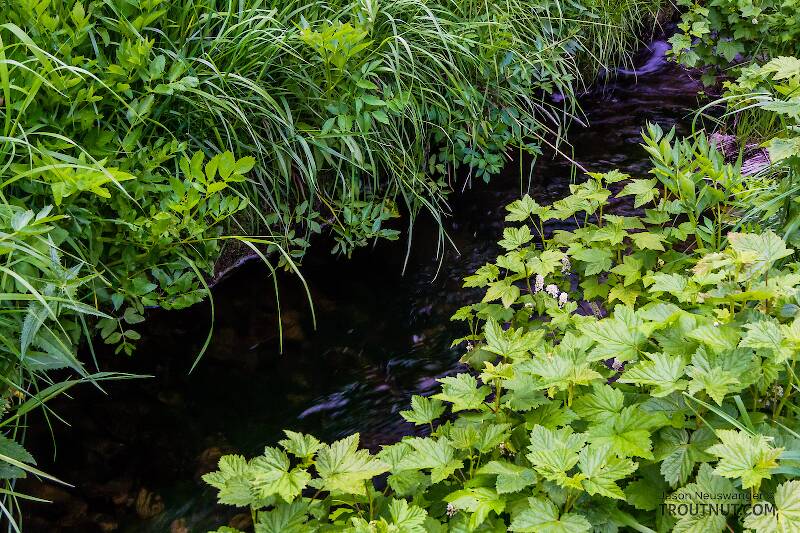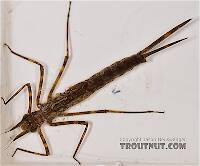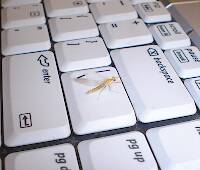
Hex Mayflies
Hexagenia limbata
The famous nocturnal Hex hatch of the Midwest (and a few other lucky locations) stirs to the surface mythically large brown trout that only touch streamers for the rest of the year.
Featured on the forum

This specimen keys to the Epeorus albertae group of species. Of the five species in that group, the two known in Washington state are Epeorus albertae and Epeorus dulciana. Of the two, albertae has been collected in vastly more locations in Washington than dulciana, suggesting it is far more common. On that basis alone I'm tentatively putting this nymph in albertae, with the large caveat that there's no real information to rule out dulciana.

Troutnut is a project started in 2003 by salmonid ecologist Jason "Troutnut" Neuswanger to help anglers and
fly tyers unabashedly embrace the entomological side of the sport. Learn more about Troutnut or
support the project for an enhanced experience here.
DrLaser
Posts: 2
Posts: 2
DrLaser on Jun 7, 2012June 7th, 2012, 2:29 pm EDT
Hello this is my first post on the site after lurking for some time and I have a quick question. I reside in Texas about 20 minutes north of Fort Worth and one day while fishing I had a mayfly hatch occur these guys ranged in size from tiny (size 18 hook) to about a size 12 hook size. Along with the mayfly population there is a healthy dragonfly and damselfly population. Now to my question how large (length wise) are mayfly, drgonfly and damselfly nymphs? The damselflys around here are mostly blue fronted dancers. I ask because I tie my own flys but I can not find anywhere actual sizes of mayfly, dragon and damsel fly nymphs any help would be appreciated
Wiflyfisher on Jun 7, 2012June 7th, 2012, 6:02 pm EDT
Don't speculate... go to the hardware store and get a small piece of nylon screen used for screen doors and two 12" long x 1/2" diameter dowels. Secure the screen to the dowels and you have a bug seine. That is what I use.
Now walk in the river and stick the seine down near the stream bottom. Put one foot out in front (upstream) and scrap the stream bottom with your foot. When you lift the seine up out of the water you should have a types of creatures to look at and use for fly tying models.
If you have a fishing buddy have him hold the home-made seine in the water while you go upstream and scrap the stream bottom with your feet.
If Texas allows you to collect specimens place them in bottle with a little water to take home and review. I prefer to use my camera and take photos of the aquatic buggers and then put them back in the river.

I also carry a small plastic container to separate the nymphs i want to examine and take photos of.

Now walk in the river and stick the seine down near the stream bottom. Put one foot out in front (upstream) and scrap the stream bottom with your foot. When you lift the seine up out of the water you should have a types of creatures to look at and use for fly tying models.
If you have a fishing buddy have him hold the home-made seine in the water while you go upstream and scrap the stream bottom with your feet.
If Texas allows you to collect specimens place them in bottle with a little water to take home and review. I prefer to use my camera and take photos of the aquatic buggers and then put them back in the river.

I also carry a small plastic container to separate the nymphs i want to examine and take photos of.

John S.
https://WiFlyFisher.com
https://WiFlyFisher.com
Taxon on Jun 7, 2012June 7th, 2012, 11:59 pm EDT
Hello DrLaser,
Welcome to this site. Wiflyfisher has offered some practical advise, and you would be wise to follow it. I will supplement that with a direct answer to your specific question:
Mayfly nymphs may vary (from ~2 mm to ~40 mm), as measured at maturity, from front of head to end of abdomen, not including tails.
Damselfly nymphs may vary from (~13 mm to ~50 mm), as measured at maturity, from front of head to end of abdomen, not including caudal lamellae.
Dragonfly nymphs may vary (from ~8 mm to ~50 mm), as measured at maturity, from front of head to end of abdomen.
Welcome to this site. Wiflyfisher has offered some practical advise, and you would be wise to follow it. I will supplement that with a direct answer to your specific question:
... how large (length wise) are mayfly, dragonfly and damselfly nymphs?
Mayfly nymphs may vary (from ~2 mm to ~40 mm), as measured at maturity, from front of head to end of abdomen, not including tails.
Damselfly nymphs may vary from (~13 mm to ~50 mm), as measured at maturity, from front of head to end of abdomen, not including caudal lamellae.
Dragonfly nymphs may vary (from ~8 mm to ~50 mm), as measured at maturity, from front of head to end of abdomen.
DrLaser
Posts: 2
Posts: 2
DrLaser on Jun 8, 2012June 8th, 2012, 6:20 am EDT
Thank you both for your replies I searched high and low over google but couldn't find exact references unfortanetly I am between two university's so I am not considered enrolled at either one otherwise I would have used ebsco databases. I'll give that homemade seine a try unfortanetly the pond with mayflys is a no wading pond but there is a small creek behind it that is open to be waded. Thank you both for your replies I'll post pictures up when I get a chance to get out unfortanetly I work this weekend :(
Wiflyfisher on Jun 8, 2012June 8th, 2012, 7:16 am EDT
For a pond I would go buy a cheap aquarium net and tape it to a wooden pole such as a wood handle from a rake. Then try dunking that in the pond to scoop out aquatic critters.
If you get the adult bugs you should be able to get some close IDs here or on some other bug websites. Then you should be able to determine the size & color of the nymphs and their characteristics.
There are also some good pretty books on pond life that might be helpful as well.
When in doubt, throw them pond fishies a small, beadhead woolly bugger in black or olive colors. :)
If you get the adult bugs you should be able to get some close IDs here or on some other bug websites. Then you should be able to determine the size & color of the nymphs and their characteristics.
There are also some good pretty books on pond life that might be helpful as well.
When in doubt, throw them pond fishies a small, beadhead woolly bugger in black or olive colors. :)
John S.
https://WiFlyFisher.com
https://WiFlyFisher.com
Quick Reply
Related Discussions
Topic
Replies
Last Reply
Re: Identification of a possible Cordulegaster Dragonfly Nymph
In Cordulegaster Dragonfly Nymph by IanB
In Cordulegaster Dragonfly Nymph by IanB
6
Feb 10, 2017
by Taxon
by Taxon





